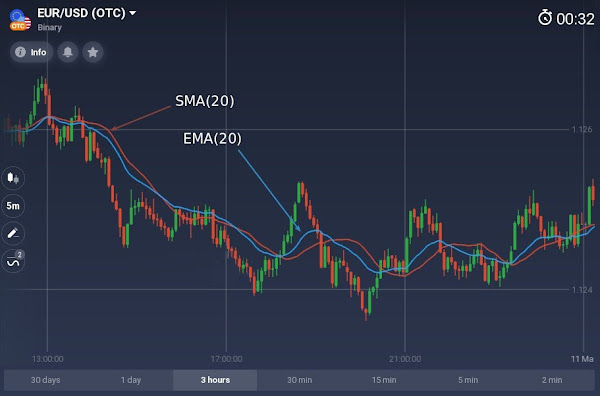Better than any moving average you know. How to use the McGinley
Simple Moving Average
The SMA calculates past closing prices and then divide them by the number of periods used for calculations. If, for example, we take a 10-day SMA, we have to add the closing prices from the last 10 days and then divide by 10. If we take a 50-day SMA, it will move slower than a 10-day one. And the smoother it is, the slower reaction to the price changes. In times of high volatility, it can be difficult to evaluate the price action and some false signals may take place. This could lead to the loss that we would rather wish to avoid.
Exponential Moving Average
The EMA pays more attention to the present prices than to the older ones. Thus, it reacts to prices much faster than the SMA. It is of great help in short term trading. Traders are commonly using both, the SMA and the EMA to get the best entry and exit points. However, the EMA is not perfect. Here, similarly to the SMA, the prices may get ahead of the market.
 |
| EMA20 reacts faster to current price changes |
McGinleys research on the moving averages
McGinley found the moving averages imperfect. The first problem was that they were too often applied incorrectly. The period of the moving averages should be adjusted to the speed of the market changes. But it is very difficult to decide whether to use 10-day or 50-day moving average at that particular moment. McGinley wanted to solve this problem by introducing an automatic adjustment of the length of the moving averages according to the speed of the market.
Another problem McGinley saw in the moving averages was that they are often too far separated from the prices. They should follow the price to give the right signals to open a position, but they fail frequently. Thus, he wanted to create an indicator that would follow the prices closely, no matter the speed of the market, and thus it would avoid whipsaws.
During his research, McGinley invented the McGinley Dynamic that was solving the above problems. The formula for calculating his indicator is as follows:

- MDi stands for the current McGinley Dynamic
- MDi-1 is a previous McGinley Dynamic
- Close means a closing price
- N is a period of the moving average
- k is a constant 60% of chosen period N
Setting up the McGinley Dynamic on Quotex
Open your account on the Quotex platform and search for the chart analysis icon. Introduce ‘mc in a search window. Then click on McGinley Dynamic and it will be added to your chart.
Now you can change the period, source (which price O, H, L or C is used for calculations), the colour and thickness of the indicators line.
The McGinley Dynamic has the appearance of a moving average, but it is much better than the latter. It reduces the separations from the price to the minimum so it avoids whipsaws. Moreover, it happens automatically thanks to the calculations applied.
How to use the McGinley Dynamic indicator
The McGinley Dynamic was created to work as a market tool, but it is also great as an indicator. It is more responsive than the SMA or the EMA. Its line moves very fast in down markets and a little bit slower in up markets.
 |
| The McGinley Dynamic (50) works perfectly as a dynamic support-resistance line |
It can be used as dynamic support or resistance line. If you draw additionally support/resistance levels on the chart, you will easily get the points of entry for your transactions.
 |
| It is a good idea to use the McGinley Dynamic in confluence with support and resistance levels |
Go straight ahead to your Quotex demo account and check the McGinley Dynamic. This is a risk-free option to try all new tools on the platform. Once you get familiar with the indicator you can move your new skills to the real account.




